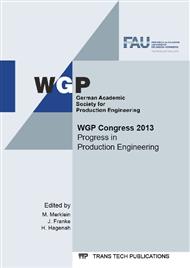p.124
p.131
p.139
p.147
p.157
p.165
p.173
p.181
p.189
Investigations on Orbital Forming of Sheet Metals to Manufacture Tailored Blanks with a Defined Sheet Thickness Variation
Abstract:
Orbital forming is an incremental bulk cold forming process with many advantages. It can produce net-shape or near-net-shape parts that have superior mechanical properties due to work hardening compared to manufacturing with cutting processes or hot forming. In this work the orbital forming process is employed in a closed-die configuration. A rising of the material thickness in the outer areas of a circular sheetmetal blank is enabled by preventing the lateral material flow. The main effects and subsequently the effects of the interaction of parameters were investigated by a two-step design of experiments. A screening plan was used to identify the statistically relevant parameters. The effects were then studied in a subsequent central-composite design of experiments. With the measured data a nonlinear response-surface model was parameterized to describe the dependency of the mould filling on the investigated process parameters. This model was validated experimentally and showed a good agreement to reality. Additionally a new concept for the tool system was developed and investigated. The form-defining cavity can be changed from the upper punch to the counterpunch.
Info:
Periodical:
Pages:
157-164
Citation:
Online since:
September 2013
Authors:
Keywords:
Price:
Сopyright:
© 2013 Trans Tech Publications Ltd. All Rights Reserved
Share:
Citation:


